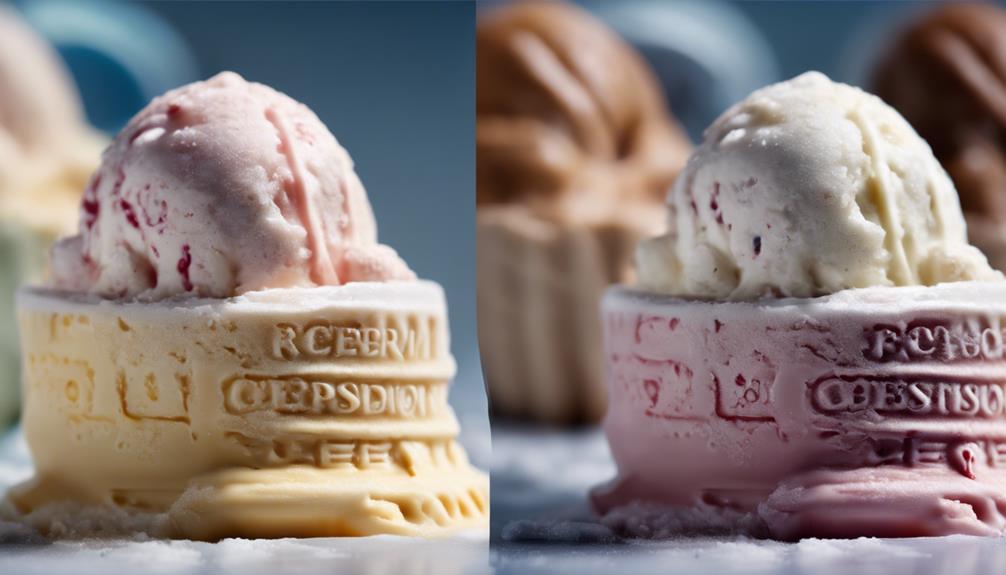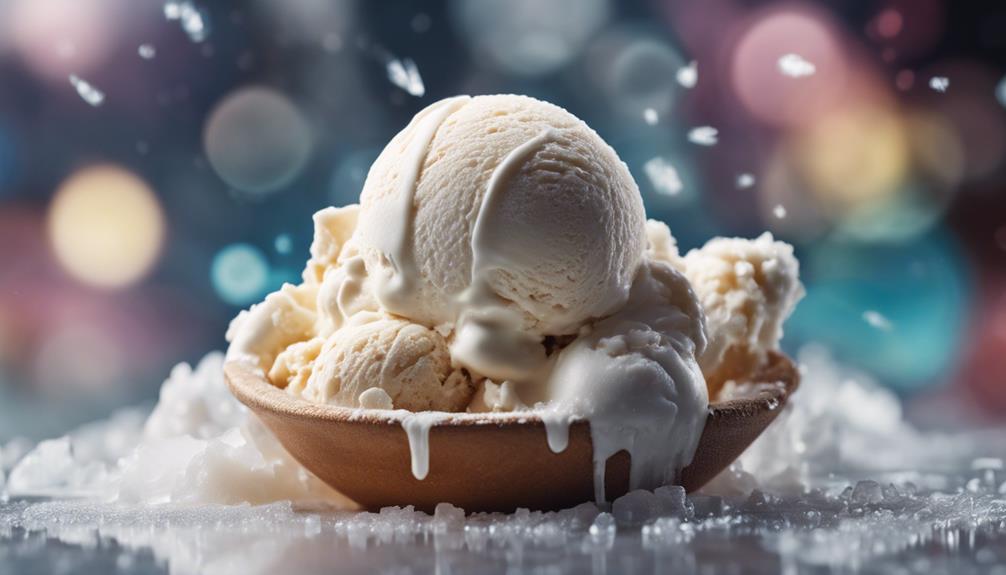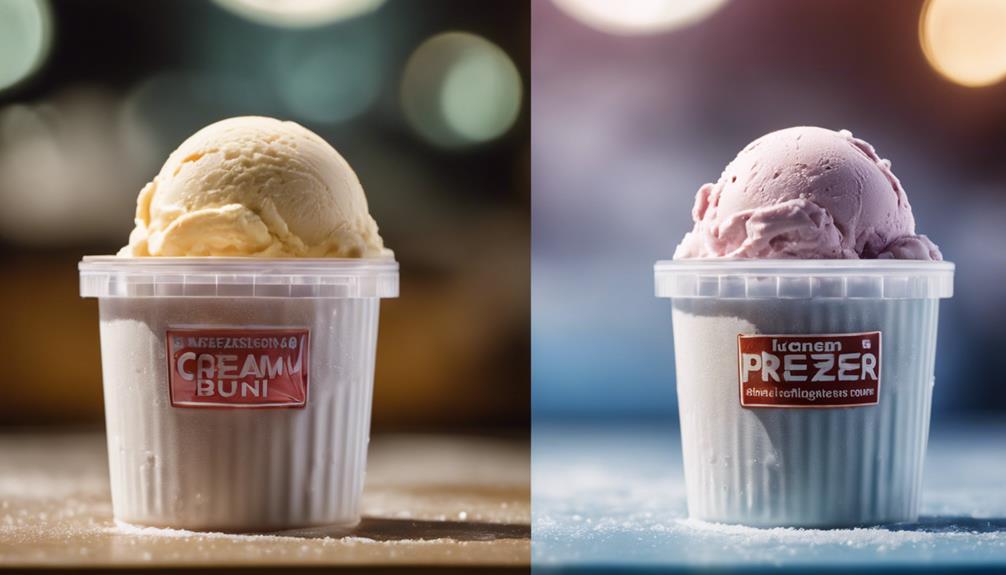When producing ice cream, ice is formed due to freezing point depression caused by ingredients such as sugar. This helps achieve a smoother texture by interfering with ice crystal formation. The freezing process includes the formation of small ice crystals through cooling and agitation. Factors like fat content and water content affect the texture. Freezing rapidly helps preserve quality and flavor. Prevent ice cream from becoming icy by understanding crystal size. Continue exploring to learn more about how freezing affects food quality and preservation!
Key Takeaways
- Ice crystals form during freezing.
- Agitation prevents large crystal growth.
- Sugar affects ice cream texture.
- Proper freezing temp crucial for smoothness.
- Understanding crystal size enhances quality.
Freezing Point Depression Fundamentals

Exploring the basics of freezing point depression involves understanding how solutes affect the freezing point of a solvent mixture. When you add solutes like sugar to ice cream, you disrupt the formation of ice crystals during freezing. This interference leads to a smoother texture in your favorite frozen treat. Freezing point depression plays an essential role in this process, as it lowers the freezing point of the ice cream mixture, preventing it from solidifying into a hard block of ice.
In the domain of ice cream production, freezing point depression is vital for achieving the desired consistency and mouthfeel. By adjusting the amount of sugar or other solutes in the mixture, ice cream makers can control the formation of ice crystals and create a creamy product that melts just right on your tongue.
Freezing Point Depression in Ice Cream Ingredients

When it comes to ice cream ingredients, understanding how freezing point depression impacts the final product is essential to achieving the desired texture and consistency. Sucrose, water content, and cocoa powder are vital factors influencing freezing point depression in ice cream ingredients. Sucrose, a common sweetener in ice cream, lowers the freezing point, preventing the ice cream from becoming too hard. Water content variations in ingredients like milk, cream, and egg yolks also play a role in freezing point depression calculations. While cocoa powder has a minimal effect on freezing point depression, it substantially influences the texture, flavor, and structure of ice cream due to its fat content and quality differences.
| Ingredient | Freezing Point Depression Impact |
|---|---|
| Sucrose | Lowers the freezing point |
| Water Content | Affects freezing point calculations |
| Cocoa Powder | Minimal impact on freezing point, but significantly texture influence |
Factors Affecting Ice Cream Texture and Stability

Factors influencing the texture and stability of ice cream encompass a range of elements vital to the overall quality of the frozen treat. The fat content plays a pivotal role in determining the richness and hardness of the ice cream. Higher fat content, such as cocoa butter from cocoa powder, contributes to firmness at freezing temperatures. Additionally, the freezing point depression caused by the fat content affects the formation of ice crystals within the ice cream, impacting its smoothness.
Temperature also plays a significant role in ice cream stability. Storing ice cream at -18°C guarantees its stability for months or even years, affecting both shelf life and texture. However, lower temperatures, while enhancing shelf life, can lead to higher energy costs, as industrial freezers may need to operate below -18°C for extended stability.
Understanding these factors, such as fat content, freezing point depression, ice crystals, and temperature, is essential to producing ice cream with the desired texture and stability.
The Freezing Process in Ice Cream Production

Cooling the ice cream mixture triggers the formation of small ice crystals necessary for achieving the desired mouthfeel and texture in the final product. These ice crystals are vital as they impact the overall texture of the ice cream.
During the freezing process, agitation is used to guarantee the formation of small ice crystals, contributing to a smoother mouthfeel. Additionally, milk fat globules are broken down through homogenization to facilitate even freezing and distribution throughout the mixture.
The freezing point of the ice cream mixture is influenced by the sugars present, which decrease the freezing temperature, ultimately affecting the texture and scoopability of the ice cream. By carefully managing factors such as ice crystal formation, milk fat distribution, and freezing temperature, ice cream producers can create a product with the desired creamy texture that consumers crave.
Food Freezing Techniques

To effectively maintain food quality and prolong shelf life, mastering proper food freezing techniques is vital. Rapid freezing plays a significant role in the freezing process by forming smaller ice crystals, which enhances food quality and helps preserve the desired texture of the food.
When freezing food, it's important to use proper packaging to prevent freezer burn and preserve the overall quality of the frozen items. Additionally, when it comes to thawing frozen food, it's recommended to do so in the refrigerator to guarantee food safety and prevent bacterial growth.
Different types of food items may require specific freezing techniques, as not all foods freeze well. By freezing food properly, decomposition is slowed down, extending the shelf life of various food products.
Understanding the importance of rapid freezing, appropriate packaging, and thawing methods is crucial for maintaining food quality and ensuring that frozen foods retain their freshness and flavor.
Science of Freezing

Now, let's talk about the science behind freezing.
Ice crystal formation and freezing point depression play important roles in determining the texture and quality of frozen products.
Understanding these processes is key to producing high-quality frozen treats.
Ice Crystal Formation
As the liquid in ice cream freezes, tiny ice crystals begin to form, shaping the texture and overall quality of the final product. The size of these ice crystals plays a pivotal role in determining the mouthfeel of the ice cream.
When ice cream is agitated during the freezing process, it encourages the formation of small ice crystals, resulting in a smoother consistency that's preferred by many. On the other hand, slow freezing can lead to the development of larger ice crystals, which can give the ice cream a grainy texture that's less desirable.
To achieve a creamy and enjoyable ice cream experience, it's vital to control the size of the ice crystals through proper freezing techniques. By understanding how ice crystal formation impacts the overall quality of the ice cream, producers can guarantee that their product has a smooth and pleasing mouthfeel that delights consumers.
Freezing Point Depression
Understanding freezing point depression is important in comprehending the science behind the freezing process. In an ice cream recipe, freezing point depression plays a vital role. It occurs when substances like sugar are added to the mixture, disrupting the formation of ice crystals and lowering the freezing point of the solution. While fat molecules in ice cream don't greatly affect the freezing point, it's the interference caused by sugar that's key in achieving the desired creamy texture.
When water molecules in the ice cream mixture interact with sugar molecules, the freezing point is lowered, allowing for a softer consistency at lower temperatures. This phenomenon is what prevents the ice cream from becoming a solid block of ice.
Rapid Freezing Benefits

When you rapidly freeze food, you're preserving its quality by forming small ice crystals that are less damaging to cell walls. This process prevents the formation of large ice crystals that can harm cell membranes and affect the texture of the food.
Unlike slow freezing, rapid freezing helps maintain the integrity of the food's structure and overall quality.
Improved Food Quality
Rapid freezing improves food quality by creating small ice crystals that lead to less harm to cell walls. This process aids in preserving the texture and flavor of frozen foods.
Here are four key ways rapid freezing benefits food quality:
- Preserves Texture: Small ice crystals generated during quick freezing result in minimal harm to the cell walls of food. This maintenance of cell structure helps uphold the original texture of the food when it's thawed.
- Enhances Flavor: By reducing cell damage, rapid freezing assists in maintaining the natural tastes of the food. This guarantees that the flavor remains unchanged even after freezing and thawing.
- Prevents Freezer Burn: Properly wrapping and sealing food before freezing is essential in averting freezer burn. Freezer burn can diminish the quality of frozen foods by changing their taste and texture.
- Maintains Nutritional Value: Rapid freezing aids in preserving the nutritional value of foods by decreasing the formation of large ice crystals that can harm cell membranes containing vital nutrients.
Crystal Size Impact
Smaller ice crystals resulting from rapid freezing play a pivotal role in enhancing the texture and quality of ice cream products. When ice cream mixtures are rapidly frozen, the formation of tiny ice crystals is favored. These small ice crystals are essential for achieving a smooth and creamy consistency in the final product. In contrast, slow freezing methods lead to the development of large ice crystals, which can damage the structure of the ice cream and result in a gritty mouthfeel.
To highlight the impact of crystal size on ice cream quality, let's compare the effects of rapid freezing versus slow freezing:
| Crystal Size | Impact on Ice Cream |
|---|---|
| Small | Smoother consistency |
| Large | Gritty texture |
It is clear that rapid freezing, which promotes the formation of small ice crystals, is advantageous for ensuring a delightful mouthfeel and overall quality in ice cream products. By understanding the importance of crystal size in the freezing process, manufacturers can create superior ice creams that meet consumer expectations for a velvety smooth texture.
Freezer Burn Prevention

To prevent freezer burn, make certain you properly wrap and seal food before placing it in the freezer. Here are some key tips to help you avoid freezer burn and keep your food fresh:
- Rapid Freezing: Freeze food quickly at low temperatures to minimize the formation of large ice crystals that can damage its texture.
- Proper Wrapping: Confirm food is tightly wrapped and sealed to reduce its exposure to air, preventing freezer burn from affecting the food.
- Enzyme Inactivation: Preserve the quality of fruits, vegetables, and other foods by blanching or cooking them before freezing to inactivate enzymes and reduce the risk of freezer burn.
- Consistent Temperature: Maintain consistent freezer temperatures, avoid frequent door openings, and consider using manual defrost freezers to further prevent freezer burn and uphold food quality during storage.
Frequently Asked Questions
Why Does My Ice Cream Have Ice in It?
You have ice in your ice cream when the freezing process isn't controlled properly. Improper mixing or temperature fluctuations can lead to larger ice crystals, affecting the creamy texture. Ensuring a controlled freeze prevents icy textures.
Is It Okay to Eat Ice Cream With Ice Crystals?
Yes, it's okay to eat ice cream with ice crystals. While it may affect texture, eating it won't harm you. Just maintain proper storage to prevent large crystals. Enjoy your treat despite the icy surprise!
Why Does Ice Form in My Frozen Food?
When your frozen food sits in the freezer, water molecules in the food freeze at low temperatures, forming ice. Proper packaging is key to prevent ice crystals. Thaw food in the fridge for safety and quality.
How to Get Rid of Ice Crystals in Ice Cream?
To banish those pesky ice crystals from your ice cream, keep things chill. Mix it up, freeze it fast, and use stabilizers. Your smooth, crystal-free treat will be worth the effort. Enjoy every scoop!
How Does the Freezing Process of Ice Cream Affect Thirst?
The ice cream and thirst relationship is an interesting phenomenon. When ice cream is frozen, its temperature lowers, causing the throat to feel dry. This can lead to increased thirst as the body tries to compensate for the cold sensation. So, the freezing process of ice cream can actually make you feel more thirsty.
Conclusion
So next time you enjoy a scoop of ice cream, remember that the freezing process is what gives it that perfect texture and taste!
Did you know that the average American consumes about 23 pounds of ice cream per year? That's a lot of frozen deliciousness!
Keep cool and keep enjoying your favorite frozen treat.
















